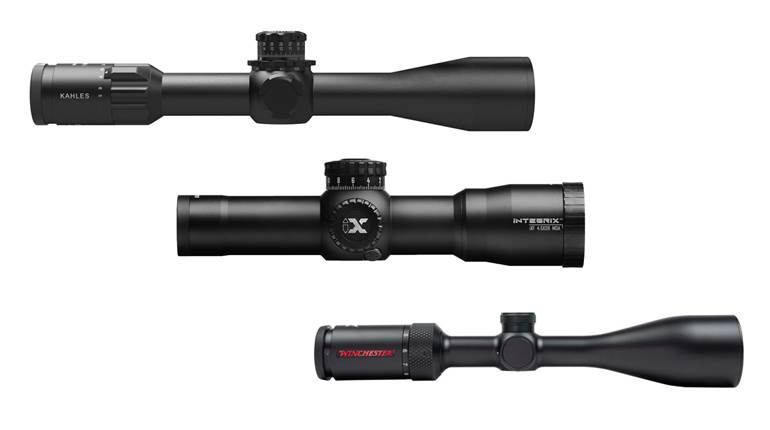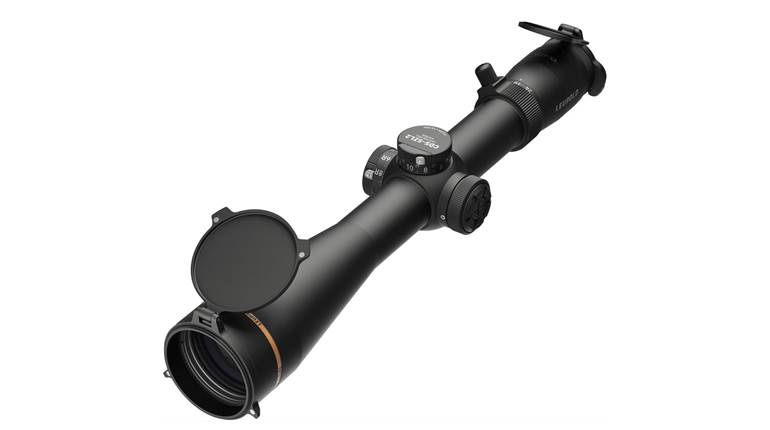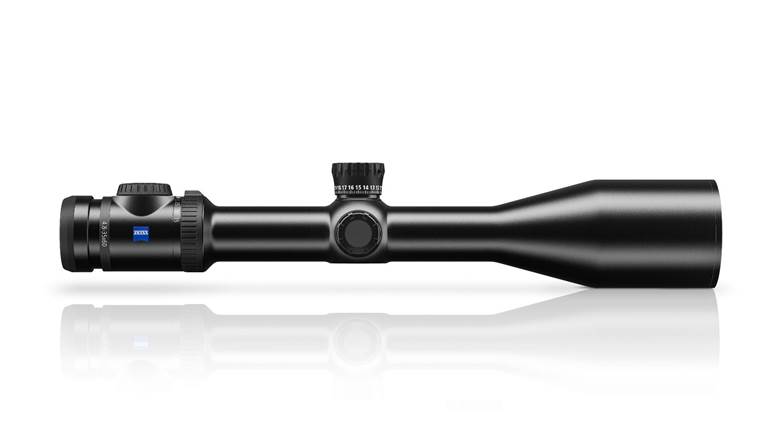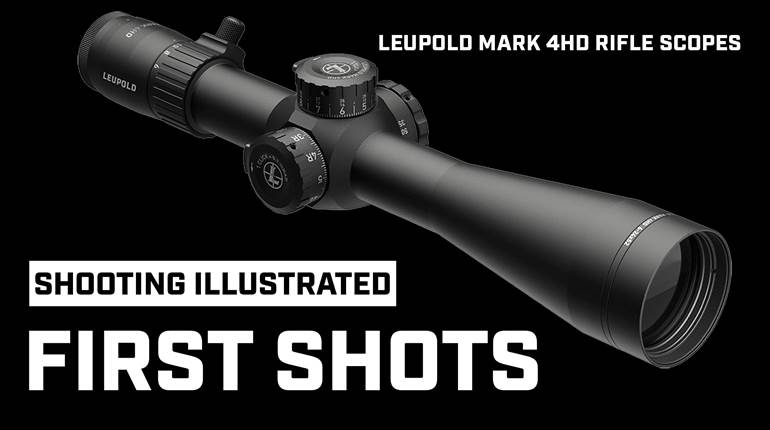
"Tactical" is the catchword of today’s shooting marketplace, and riflescopes have not been excluded from this trend. Almost all optics manufacturers offer one or more “tactical” models, usually hunting scopes cosmetically modified with target-type knobs, a matte-black finish, and perhaps a rangefinding reticle of some sort. Increasingly sophisticated consumers, however, have come to demand features typical of real-world tactical scopes. Bushnell has addressed this demand with two models in its Elite Tactical line, the 3-12X 44 mm and the 6-24X 50 mm. While the 3-12X model is available only with an illuminated reticle, the 6-24X scope can be had in illuminated and non-illuminated reticle versions.
Today’s tactical scopes are employed for both aiming and precise range estimation, and have three specific characteristics. The first is the mil-dot reticle, which consists of precisely spaced dots of specific size in mils (1 mil equals approximately 36 inches at 1,000 yards). By determining the number of mils an object of known size subtends, an experienced user can quickly calculate its distance. While most military reticles employ elongated mil-dots, Bushnell uses a simplified, but still effective, reticle with round dots of 0.5-mil diameter, spaced one mil apart.
The second characteristic of modern tactical optics is 1/10-mil click adjustments. While mil-dot reticles are sometimes offered on scopes with 1/4-minute-of-angle (m.o.a.) clicks, professional tactical shooters consider calculating completely in mils to be far simpler. Thus, Bushnell’s 3-12X 44 mm and 6-24X 50 mm Elite Tactical scopes feature both mil-dot reticles and zeroable turrets having 1/10-mil click adjustments (1/10 mil equals approximately 0.36 inches at 100 yards) Such scopes are often called “mil/mil” scopes.
Finally, modern tactical variable-power scopes have the mil-dot reticle in the first focal plane (FFP). In FFP scopes, the apparent reticle size changes proportionately with the scope’s magnification, allowing the mil-dot system to be employed at all power settings. Among the seven scopes in Bushnell’s Elite Tactical line, only the 3-12X 44 mm and 6-24X 50 mm models have FFP reticles.
Bushnell saw the need for an optic offering uncompromising quality, all the essential features of a true tactical scope, and a retail price of less than $1,000. Using input from tactical shooters and gun builders, the company developed the Elite Tactical FFP scopes. Like the other Elite Tactical scopes, they offer saddle-mounted parallax focus, a rubber-cushioned fast-focus eyepiece, and target-type turrets, and are waterproof, fog-proof and shock-proof.
When first introduced in 2010, the Elite Tactical FFP scopes were catalogued as part of the Elite 4200 series. That designation was eliminated in 2011, which also saw improvements to the Elite Tactical line, including increased windage and elevation adjustment ranges.
The 30 mm main tube, objective bell, ocular bell and saddle are all made in one piece from 6061 aluminum via a “cold molding” process, which yields a stronger component than hammer-forging. Main tube wall thickness is 3 mm, or nearly 1/8 inch. External tube surfaces have a black, non-glare anodized finish.
All Elite Tactical lenses are produced in one of Japan’s premier optics facilities. Traditional polishing methods, which better maintain tolerances all the way to the lens edge, contribute to the scope’s high optical resolution of 3.6 seconds of arc. All lens surfaces have Bushnell’s proprietary Ultra Wide Band coating, which transmits 99.8 percent of the visible light at each surface, giving 95 percent light transmission through the entire scope. Exterior lens surfaces have a water-repelling RainGuard HD coating, and the scope’s interior is purged with argon gas.
The reticle, sandwiched between two lenses for structural integrity, is created by chromium deposition. Illuminated-reticle models feature an additional superimposed etched-reticle pattern, as well as a combination battery compartment and rheostat on the ocular marked with 10 illumination levels (although intermediate levels are also possible). Contributing to the scope’s mechanical precision and ruggedness are features such as machining tolerances as close as one micron, a solid brass power cam and aluminum-titanium alloy springs. All Elite scopes are tested to withstand 10,000 cycles of 650g acceleration, simulating the recoil of a .375 H&H Mag. sporting rifle.
The Elite Tactical 6-24X 50 mm scope we received gave a favorable first impression. Its 27-ounce heft attested to its robust construction; its 5-mil-per-revolution turrets allowed easy manipulation even with gloves, and showed positive click values; and all markings were clear, and etched—not just painted—into the turret and scope tube surfaces. We also appreciated its broad range of reticle illumination levels, its generous 4 inches of eye relief, and its 70-m.o.a. windage and elevation range, which may eliminate the need, on some rifles, to use an angled base for long-range work.
We mounted the scope on a custom .308 Win. rifle featuring a Remington Model 700 action from Brownells, Inc. and a Shilen match barrel, Accuracy International stock, and TSR rings and base from Midway USA. At the range, return-to-zero and “shooting the square” tests showed accurate and repeatable tracking. Optically, the scope demonstrated excellent brightness, faithful color rendition and a high level of sharpness. Viewing a grid of closely-spaced lines, at various scope magnifications, revealed no pincushion or barrel distortion, and the grid was sharp to the edge of the visual field.
After immersion in water for one hour, followed by eight hours in a freezer at 28 degrees F, the scope showed no condensation or other indication of failure of the its waterproof seals, and tracking accuracy was unchanged. We also used the scope to range objects of known size at 50 to 500 yards. The distances obtained using the mil-dot reticle corresponded well to those measured by a Bushnell laser rangefinder.
Bushnell did not include lockable turrets or a zero-stop feature on the Elite Tactical in order to meet the desired sub-$1,000 price without sacrificing basic quality. These attributes may be available on future models of the line.
In recent years, Bushnell has increased its presence in the tactical scope market, such as hiring Tom Fuller, formerly top NCO at the USAMU, to head the company’s military sales effort, and partnering with Horus to develop the HDMR rifle scope. Judging from our sample Elite Tactical 6-24X 50 mm FFP scope, Bushnell may be ready to compete with some of the best of the tactical optics breed.
Importer: Bushnell Outdoor Products; (800) 423-3537; www.bushnell.com
Model: ET6245F
Magnification and Objective: 6-24X 50 mm
Finish: matte black anodizing
Field of View (FT. @ 100 YDS.): 17.5 ft. (6X), 4.5 ft. (24X)
Eye Relief: 4.0"
Exit Pupil: 7.5 mm@6X; 2.1 mm@24X
Click Value: 1/10 mil (0.36" @ 100 yds.)
Windage and Elevation Adjustment Range: 70" @ 100 yds. (W), 70" @ 100 yds. (E)
Reticle: illuminated mil-dot, first focal plane
Length: 131⁄2"
Weight: 27 ozs.
Features: 30 mm tube, saddle-mounted parallax focus from 25 yards to infinity, rubber-cushioned fast-focus ring, zeroable target-type turrets, RainGuard HD and Ultra Wide Band lens coatings
Accessories: 3" sunshade, hex wrench, CR-2032 battery, rubber scope cover, owner’s manual
Suggested List Price: $999






































